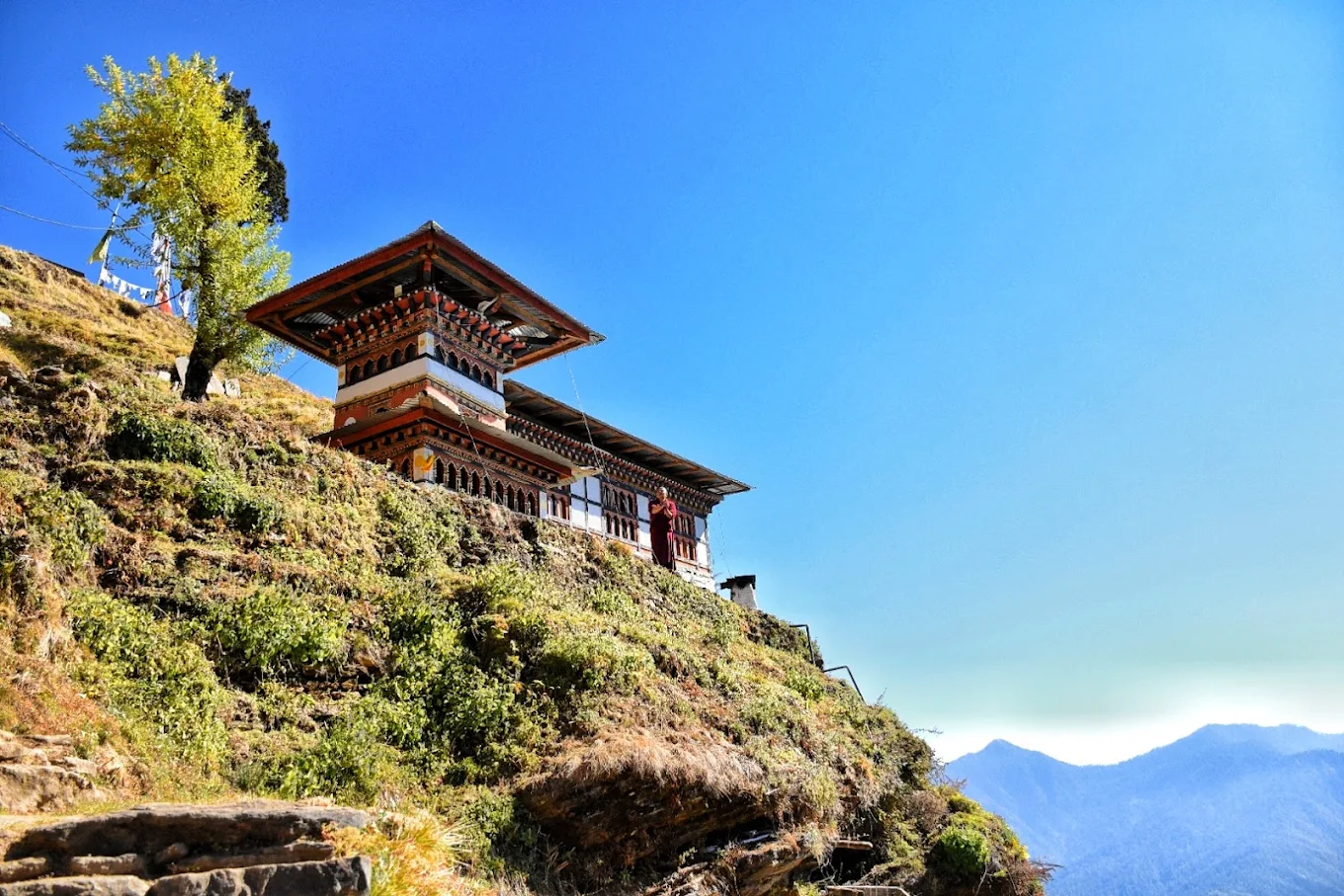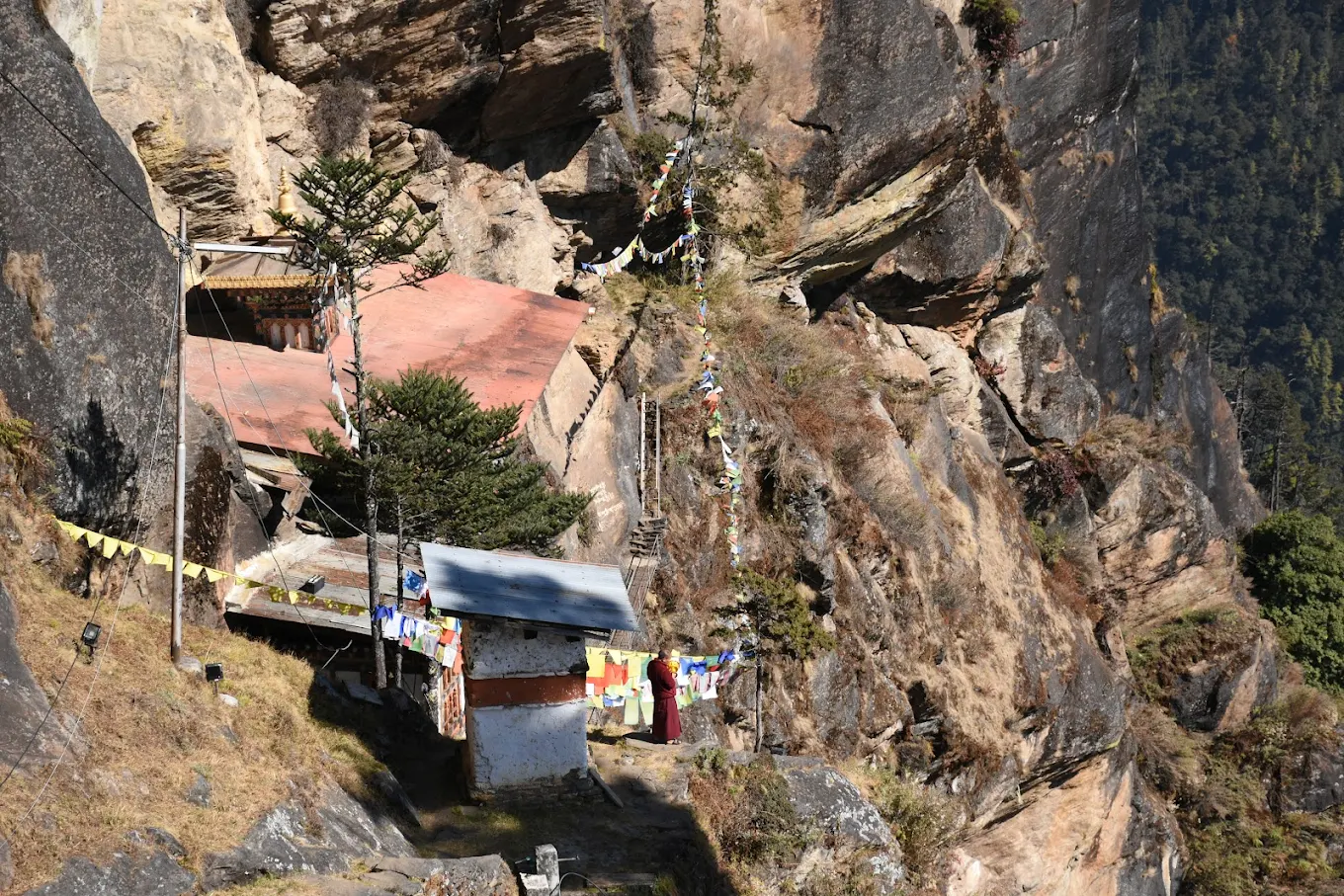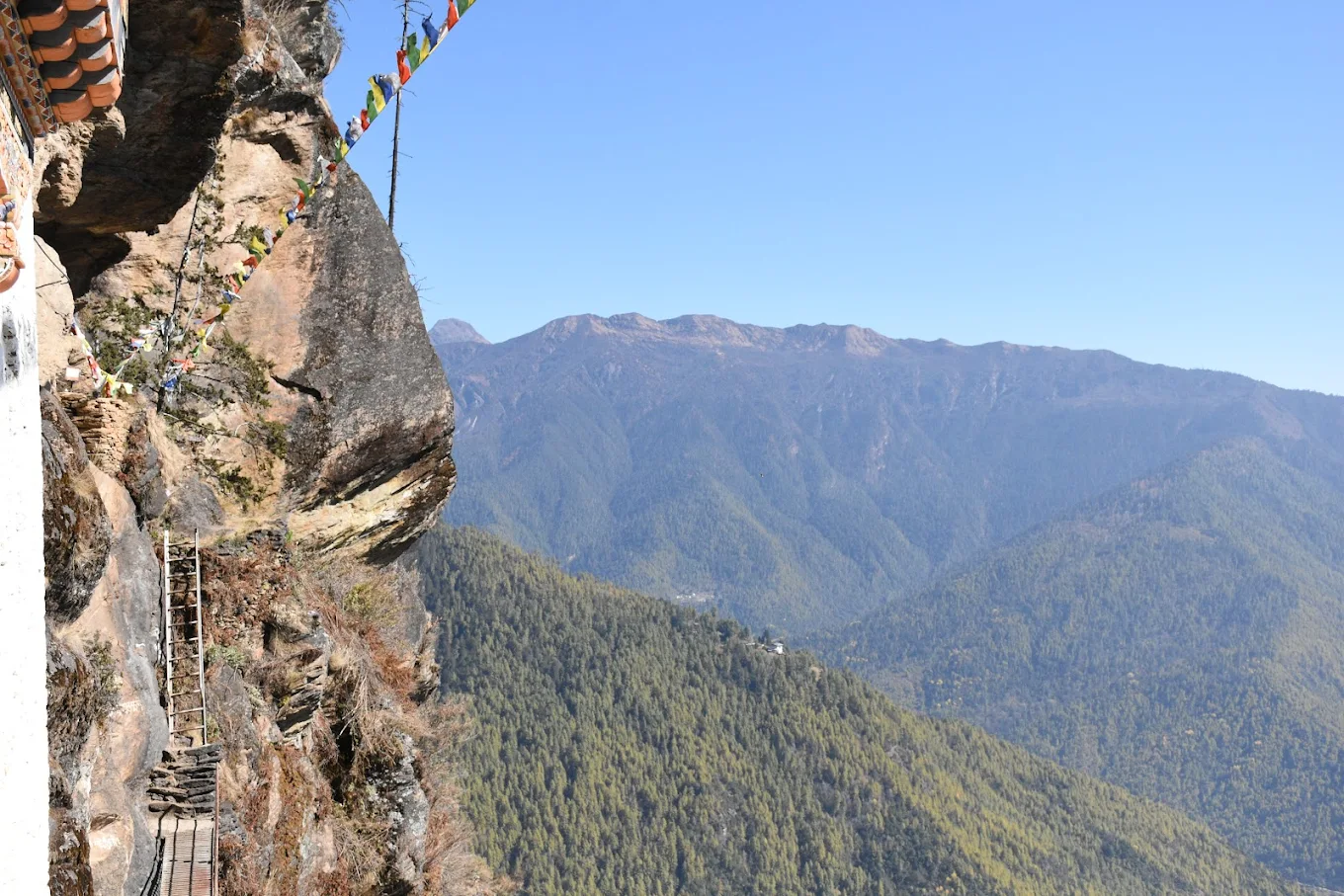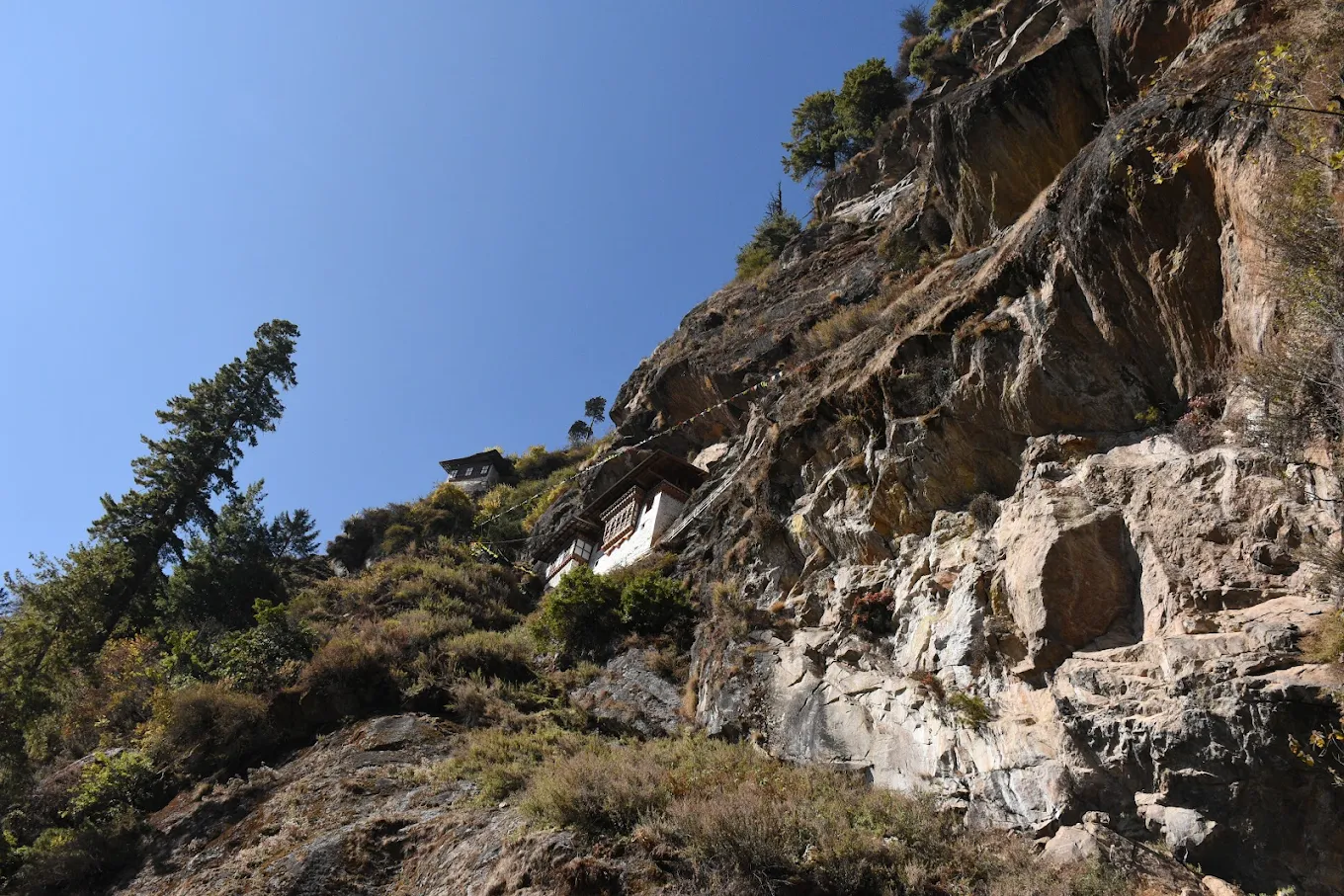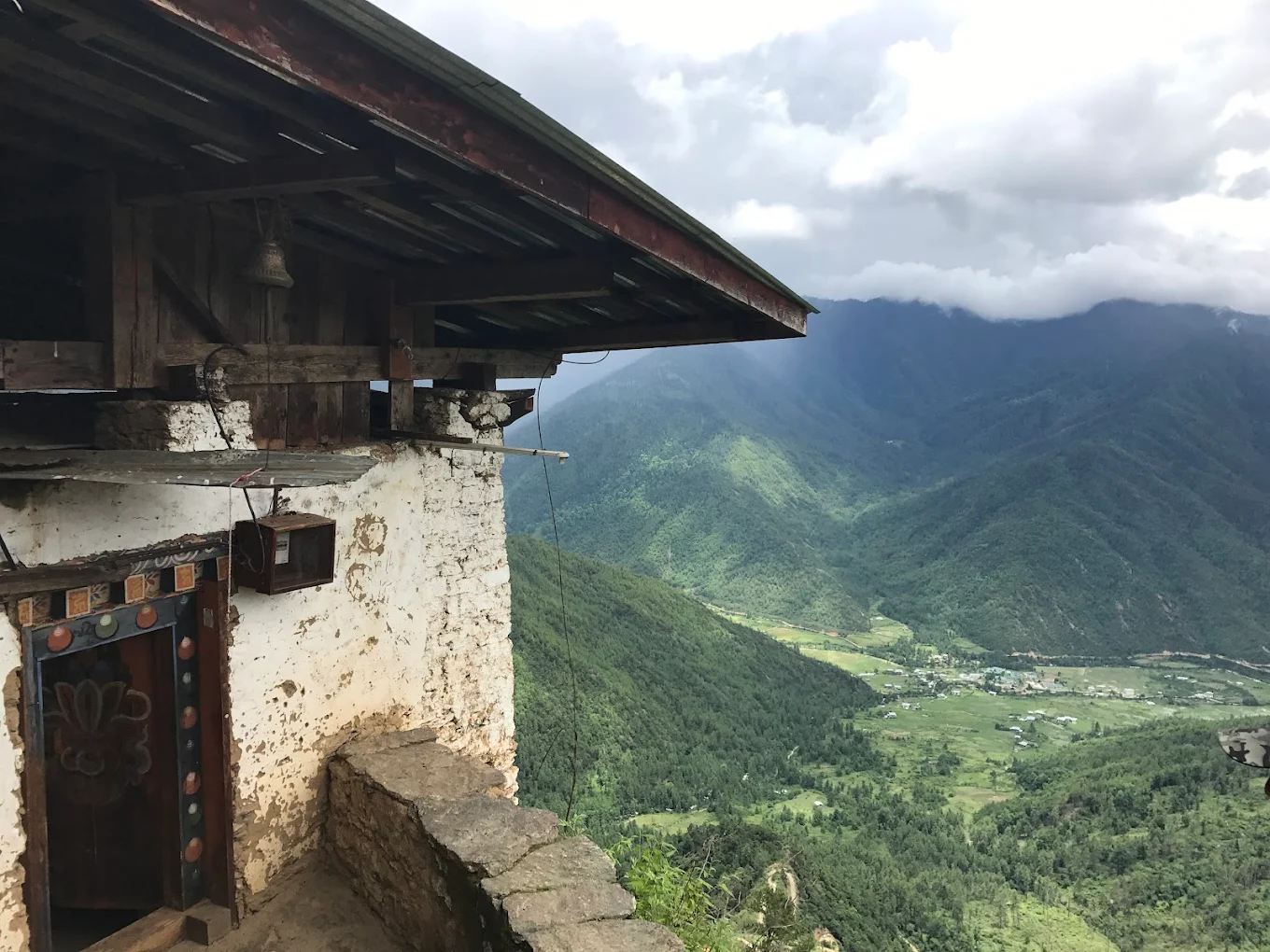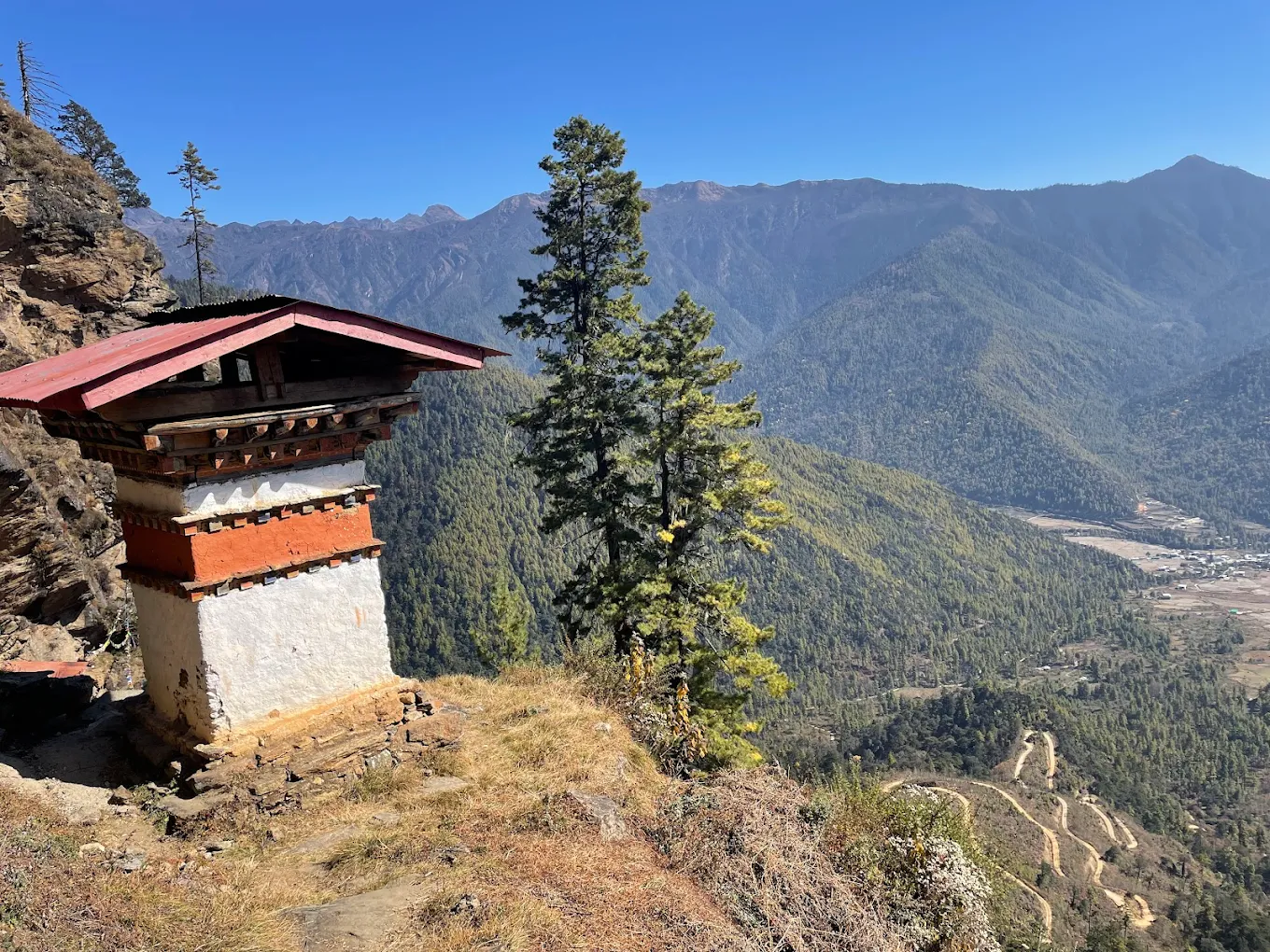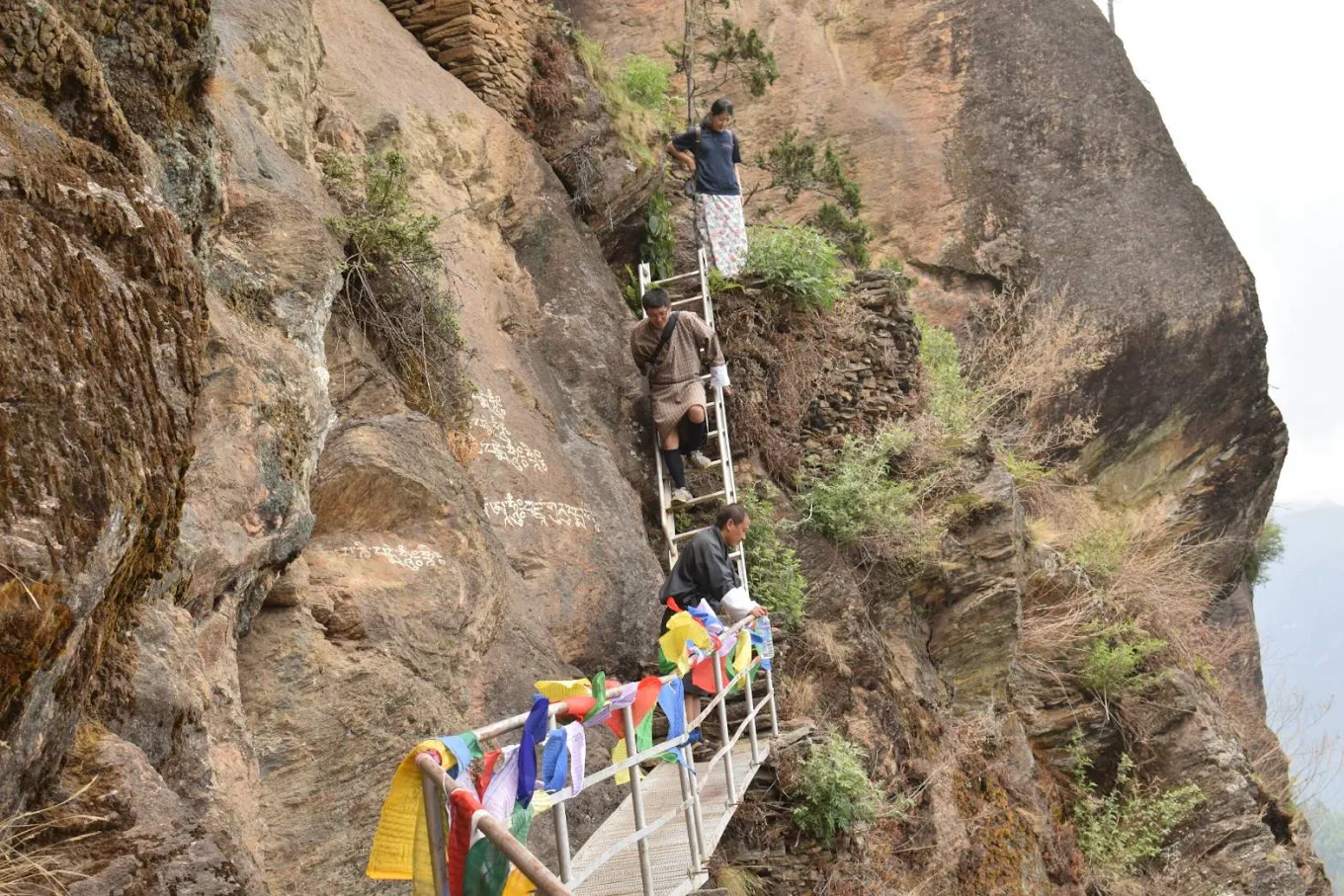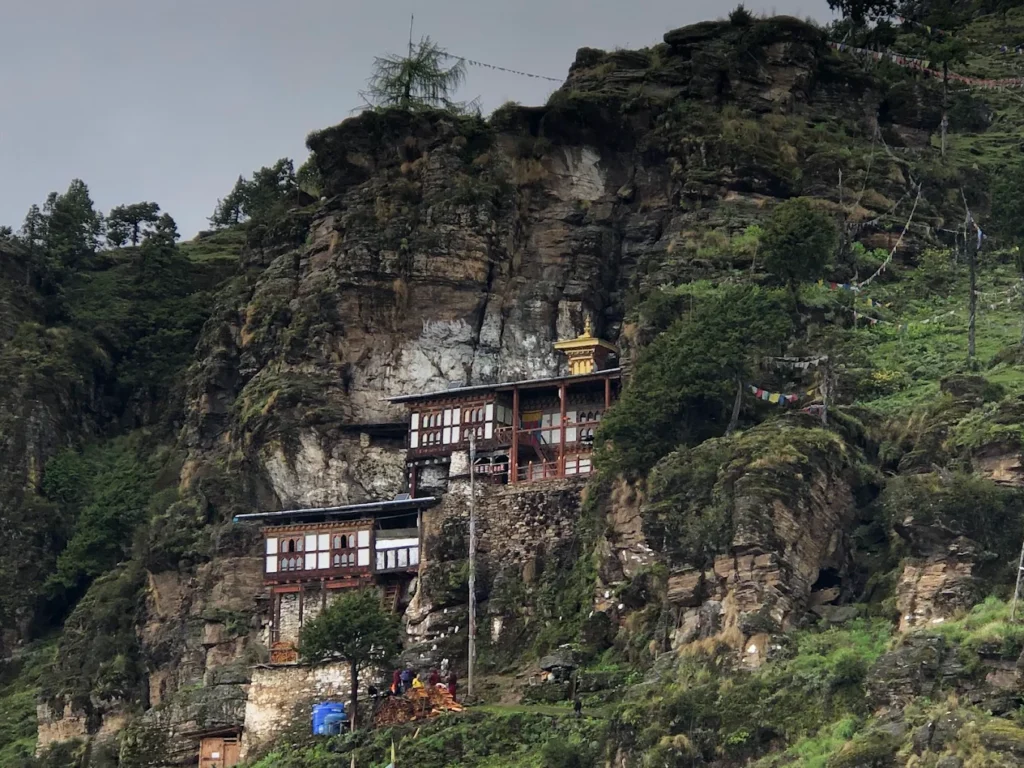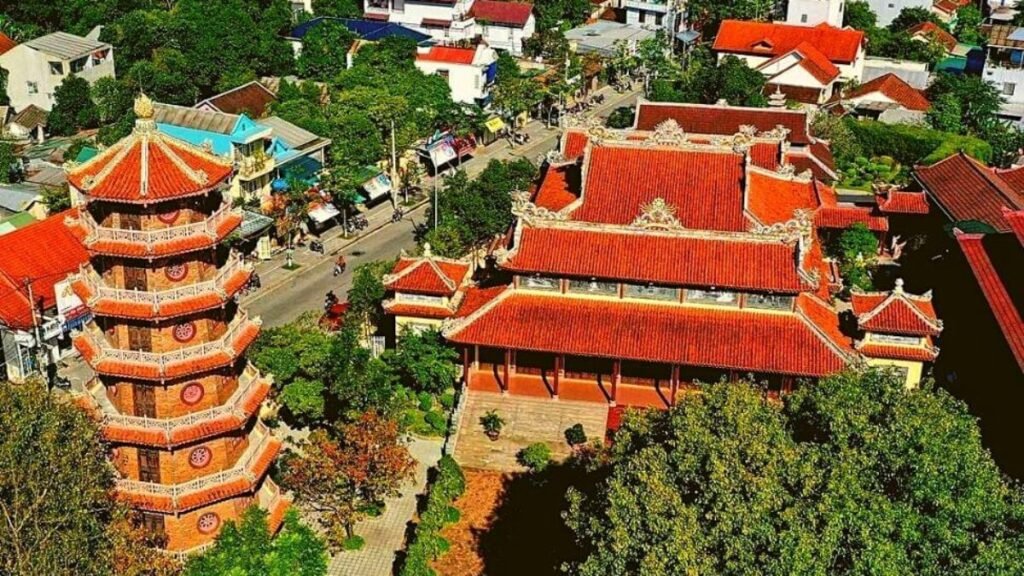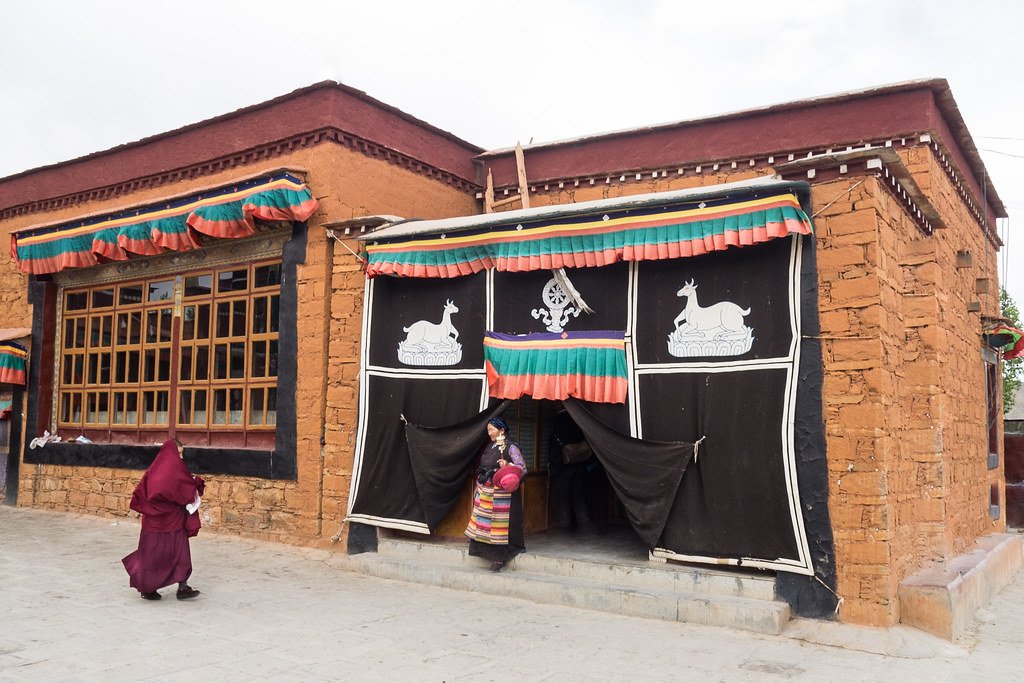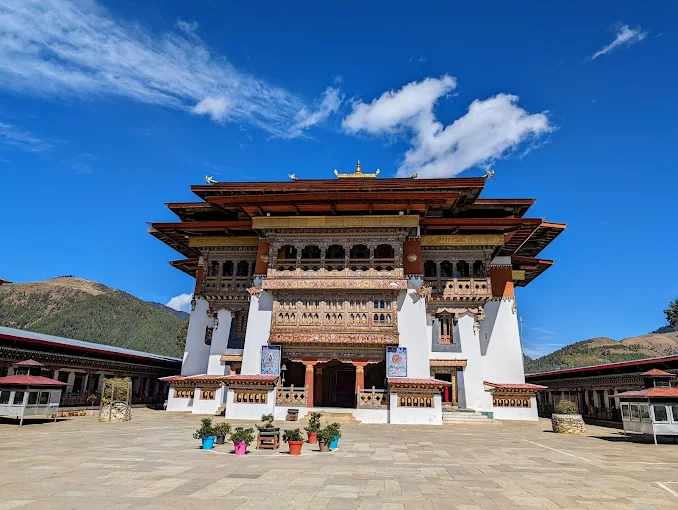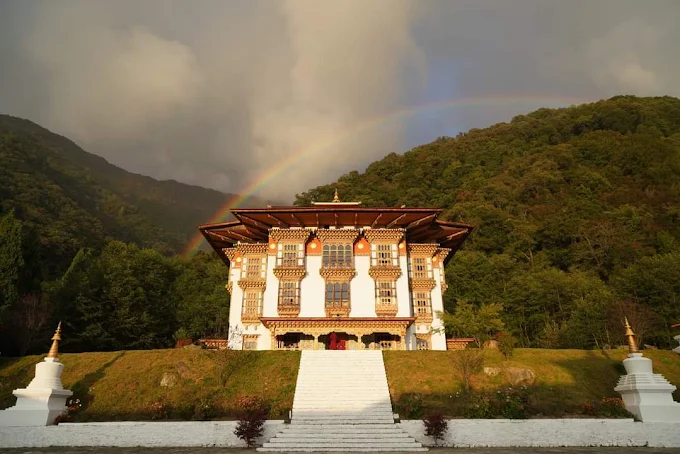Ragoe Monastery: Cliffside Sanctuary of Paro’s Nyingma Legacy
As dawn crests Paro’s rugged cliffs, Ragoe Monastery stirs in Atsho-Phunum village, its whitewashed walls pressed against a sheer rock face at 2,800 meters. Within, the self-spoken Guru Sungjoen, a bronze statue of Guru Rinpoche (Padmasambhava), gleams beside Chana Dorji and Jetsuen Milarepa, their altar framed by murals of the Trinity of Longevity. Butter lamps flicker against a cliff etched with dakini footprints, while two holy springs—Drupchhu and Shang Chhu—murmur nearby. During Tshechu, masked dancers swirl in the courtyard, their steps echoing Nyingma’s ancient rhythms. Blessed by Guru Rinpoche in the 8th century and built by Lopen Tshewang Tenzin after a divine vision, this lhakhang in Doteng Gewog harbors a meditation cave where celestial blessings linger. Amid Paro’s misty pines, Ragoe Monastery weaves myth, devotion, and Sharchop community life, offering a sanctuary where Bhutan’s spiritual pulse thrums.
Overview and Significance
Ragoe Monastery, nestled against Paro’s cliffs in Atsho-Phunum village, stands as a Nyingma haven, its Guru Sungjoen statue and dakini relics embodying 8th-century sanctity. This temple weaves legend, meditation, and community, anchoring Bhutan’s spiritual heritage.
Introduction to Ragoe Monastery
Ragoe Monastery, known as Ragoe Guru Lhakhang, clings to a cliff in Doteng Gewog, its white walls and wooden roof a beacon of Nyingma Buddhism, Bhutan’s oldest school, rooted in Dzogpachenpo teachings. Blessed by Guru Rinpoche in the 8th century, it houses Guru Sungjoen, a self-spoken statue brought from Punakha by a goat and vulture, believed to have spoken twice. Founded by Lopen Tshewang Tenzin after a vision of Padmasambhava, it serves Paro’s Sharchop villagers, its cave and springs drawing pilgrims. Overlooking Paro Valley’s pines, it offers a glimpse into Bhutan’s Nyingma soul.
Historical Journey
The monastery’s story spans centuries:
- 8th-Century Blessing: Guru Rinpoche meditated in the cave, consecrating the cliff with dakini footprints.
- Sacred Relic: Guru Sungjoen arrived from Punakha, guided by divine animals.
- Founding: Lopen Tshewang Tenzin built the temple atop the cave, inspired by a vision.
- Legacy: Tenzin attained rainbow light, cementing Ragoe’s sanctity.
Cultural Significance
The monastery shapes Paro’s spiritual landscape:
- Nyingma Nexus: Transmits Dzogpachenpo, guiding meditation.
- Community Heart: Tshechu unites Atsho-Phunum’s villagers.
- Mythic Symbol: Guru Sungjoen embodies divine presence.
Unique Legacy
Its self-spoken statue and dakini relics define Ragoe’s sacred identity.
Community and Global Impact
- Local Bonds: Hosts rituals, binding Paro’s Sharchop community.
- Pilgrim Draw: Attracts Bhutanese devotees to its cave.
- Cultural Note: Inspires Nyingma pilgrimage traditions.
Historical Anecdotes
- A goat and vulture carried Guru Sungjoen to Ragoe’s cliff.
- Tenzin’s vision of Guru Rinpoche sparked the temple’s creation.
Social Role
Ceremonies and meditations knit spiritual and social threads.
Artistic Influence
Its murals inspire Paro’s thangka artisans.
The monastery’s history shapes its form, where cliffs and chorten frame a space of reverence.
Architectural and Spiritual Features
Ragoe Monastery’s cliffside temple and vibrant murals blend Nyingma austerity with Bhutanese craft, its meditation cave a sacred anchor. This section unveils its design and relics.
Iconic Design
The monastery’s whitewashed stone walls, pressed against a sheer cliff at 2,800 meters, are topped with a sloped wooden roof. Its courtyard, fringed by prayer flags, overlooks Paro’s misty pines, with a chorten marking the sacred site.
Key Structures
- Main Prayer Hall (Lhakhang): A compact chamber with colorful murals and altars.
- Meditation Cave: Guru Rinpoche’s 8th-century retreat beneath the temple.
- Chorten: A golden stupa, a meditative focal point.
- Caretakers’ Hut: A modest shelter for resident monks.
Worshipped Statues/Deities
- Guru Sungjoen: A self-spoken bronze Guru Rinpoche, believed to have spoken twice.
- Chana Dorji: A Vajrapani statue, protector of the faith.
- Jetsuen Milarepa: Honors the yogi’s ascetic legacy.
- Guru Tshokhor Sum: Includes Guru Rinpoche, Mandharava, Yeshe Tsogyal.
Materials and Techniques
Stone walls and timber beams, with mineral-pigment murals, reflect Bhutanese artistry.
Signature Elements
The Guru Sungjoen statue and dakini footprint cliff define the monastery’s sanctity.
Lesser-Known Features
- Holy Springs: Drupchhu (Bumdra’s holy water) and Shang Chhu (deity’s spring) flank the temple.
- Cliff Relics: Impressions of Guru Rinpoche’s steed and an ogress’s skin.
Preservation Efforts
Caretakers maintain murals against Paro’s dampness, preserving cliffside relics.
Environmental Integration
The cliffside perch ties the monastery to Paro’s rugged peaks, a serene retreat.
Artisan Narratives
Paro painters crafted murals of the Trinity of Longevity, blending Nyingma iconography.
Symbolic Details
Dakini footprints signify celestial blessings; chorten evokes purity.
Landscape Integration
Paro Valley views enhance meditative calm, grounding the monastery.
These spaces cradle the monastery’s rituals, inviting pilgrims into Nyingma’s meditative heart.
Rituals and Practices
Ragoe Monastery’s rituals, rooted in Nyingma’s Dzogpachenpo, blend chant and contemplation, fostering enlightenment. This section explores its ceremonial pulse.
Daily Sacred Rites
- Sutra Chanting: Caretakers recite Nyingma texts at dawn.
- Offerings: Butter lamps and incense honor Guru Sungjoen.
- Meditation: Dzogchen sessions focus on innate wisdom.
Unique Practices
Pilgrims offer water at Drupchhu spring during Tshechu, seeking Guru Rinpoche’s blessings.
Festival Traditions
- Tshechu: In October, masked dances honor Mandharava and Yeshe Tsogyal.
- Losar: New Year prayers bless Atsho-Phunum’s community.
Visitor Engagement
Guests may join chants or meditate in the cave, guided by caretakers.
Spiritual Community Roles
Caretakers lead rites; Sharchop villagers support festivals.
Interfaith Connections
Exchanges with Kagyu monks near Paro Taktsang reflect harmony.
Ritual Symbolism
- Butter Lamps: Light signifies wisdom.
- Holy Springs: Water evokes purification.
Seasonal Variations
Tshechu intensifies in autumn; winter retreats deepen meditation.
Monastic/Community Life
Caretakers meditate; villagers tend the courtyard.
These rituals guide visitors to the monastery’s philosophical depths.
Visitor Information
Ragoe Monastery welcomes travelers to Paro’s cliffs, offering practical details to engage with its sacred core.
Navigating to Ragoe Monastery
In Atsho-Phunum village, a 30-minute trek from Doteng Gewog’s road, the monastery’s cliffside chorten rises amid pines, 15 km from Paro town.
Address of Ragoe Monastery
Atsho-Phunum, Doteng Gewog, Paro District, Bhutan
Visiting Hours and Etiquette
- Hours: Open daily from 7:00 AM to 5:00 PM, extended during Tshechu.
- Etiquette: Dress modestly; remove shoes in the prayer hall; no photography inside.
Transport Options
- Car: A 30-minute drive from Paro to Doteng, then trek.
- Trekking: 30-minute hike from Doteng, guided or self-led.
- Bus: Paro-Doteng buses, then trek.
Accessibility and Safety
- Accessibility: Steep trail limits access; courtyard is flat.
- Safety: Paro is safe, but carry water for the trek.
Amenities and Surroundings
No permanent restrooms; Atsho-Phunum village offers tea stalls.
Immersive Tips
Visit in October for Tshechu dances or meditate by Drupchhu spring.
Nearby Cultural Experiences
- Paro Taktsang: 20 km away, Bhutan’s iconic cliffside temple.
- Rinpung Dzong: 15 km away, Paro’s administrative fortress.
Photography Tips
Frame the chorten with cliffs at sunrise; respect altar restrictions.
The monastery’s gates open to its Nyingma philosophy, where myth and faith unfold.
Cultural and Spiritual Insights
Ragoe Monastery’s essence lies in its Nyingma roots and Paro’s spirit, offering insights into Bhutan’s sacred depth.
Religious Philosophy
Nyingma’s Dzogpachenpo teaches innate wisdom, guiding pilgrims to liberation.
Environmental Spirituality
Paro’s cliffs and springs reflect nature’s sanctity, a Nyingma value.
Artistic Symbolism
Guru Sungjoen embodies divine speech; dakini footprints signify celestial presence.
Community Resilience
The monastery uplifts Atsho-Phunum, fostering Sharchop devotion.
Environmental Stewardship
Villagers plant pines, honoring Bhutan’s eco-ethos.
Meditative Practices
Dzogchen sessions cultivate clarity, open to pilgrims.
Cultural Narratives
Dakini legends inspire Tshechu tales, binding villagers.
Historical Context
The monastery ties to Paro’s 8th-century Nyingma spread.
These insights weave a reflection on the monastery’s enduring presence.
Conclusion
Ragoe Monastery shines as a cliffside sanctuary of Paro’s Nyingma heritage, its self-spoken Guru Sungjoen and dakini footprints a testament to Guru Rinpoche’s 8th-century blessing. Tshechu’s masked dances and Dzogchen meditations pulse with wisdom, weaving serenity into Atsho-Phunum’s highlands. From its meditation cave to holy springs, it fosters enlightenment amid Paro’s cliffs. As a Nyingma landmark, it bridges Bhutan’s mythic past with its vibrant present, inviting travelers to pause where prayer flags whisper timeless devotion.
